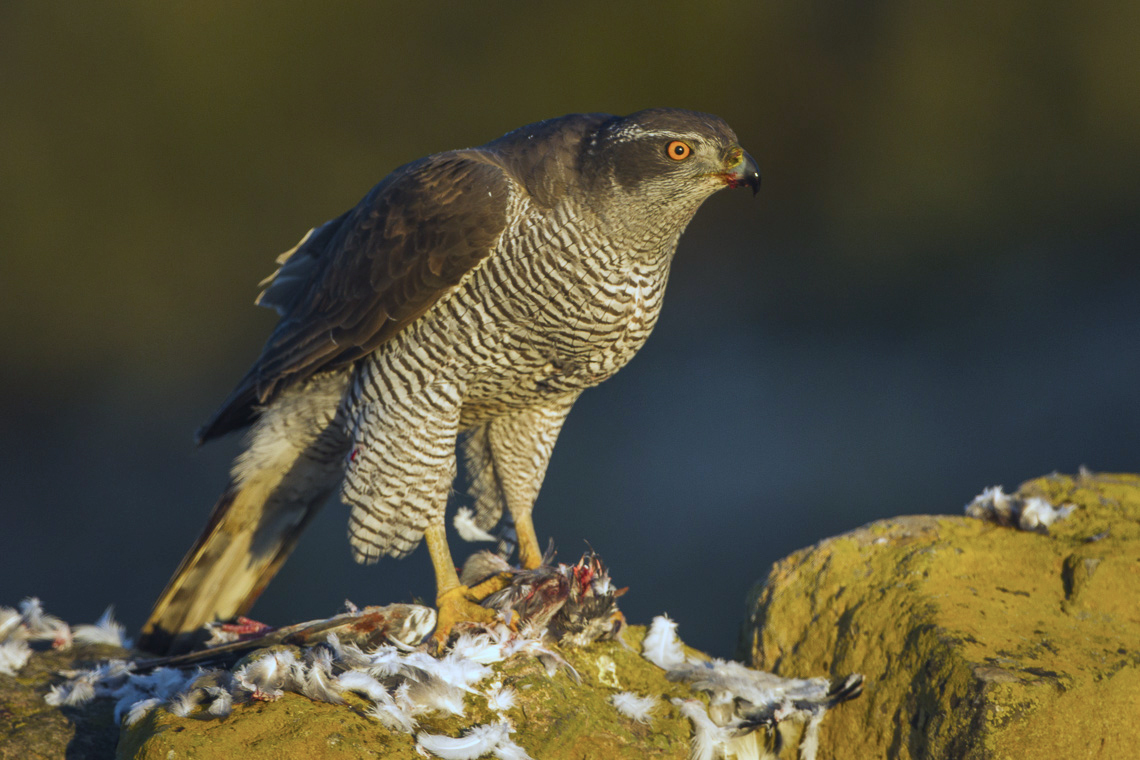Early in the Vendel Period (c. 530-750 AD), elite graves from Scandinavia began to feature massive quantities of animal bones, buried or burnt alongside human remains. Most of these were the sort of domestic species you would expect from an old European farming society: horses, dogs, sheep, and the like. But along with all of these species, archaeologists have also discovered the remains of a variety of different raptors.
Of course, while raptors (and all other birds aside) are descended from dinosaurs, we are not referring to Velociraptors or any other dromaeosaur here. Rather, we are talking about the original meaning of the term “raptor”—that is, a bird of prey. This is a category of hypercarnivorous birds encompassing a diverse range of species: from tiny falcons to massive eagles; scavenging vultures to ambushing owls; soaring hawks to sprinting terror birds (the latter mercifully extinct along with the dinosaurs). Many raptors are among the keystone species of their environments and often feature prominently in culture and myth, frequently as symbols of power and/or embodiments of sky gods.
Aside from their mythic connotations, some human societies have developed a symbiotic relationship with raptors, taming them to hunt a variety of different prey species. This practice is known broadly as falconry, although it is by no means restricted to the use of falcons: hawks, eagles, and even owls (probably used as lures more than active hunters themselves) are used, though the technique varies according to each species’ natural style of hunting, as does the prey they are typically employed to hunt. Hares, rabbits, squirrels, other birds, and even small deer are all within the falconer’s sights, if they have the right companion.
Needless to say, however, this is an extremely specialised hunting strategy, requiring diligent training on the part of both the falconer and the bird itself. It requires close communication and understanding between the two hunters. Furthermore, no species of raptor is truly domesticated; those employed in falconry are tamed wild animals. The distinction is important. Teaching a wild animal to work closely with a human is a much taller order than teaching a domestic species, which has evolved symbiotically alongside human companionship for generations.
Curiously, although birds have been symbolically charged in Scandinavia since the Bronze Age, this literal addition of raptors to the Nordic elite menagerie appears to have occurred very suddenly in the Late Iron Age. So how, and why, might humans have suddenly decided to partner symbiotically with these powerful birds among whom they had been living for millennia?
Origins of falconry
The origins of falconry, like the origins of many human-animal relationships, are murky. It is most likely to have originated somewhere on the central Asian steppe or in the Near East (or independently in both), anywhere between 3000-6000 years ago. By the Roman period, it was widespread throughout Asia and had made its way into the southern Balkans. In the first few centuries of the Common Era, the Ostrogoths living in this same region appear to have become the first Germanic tribe to have adopted the practice.
Shortly after this, as the Migration Period (c. 350-530 AD) unfolded, Europe witnessed the arrival of a variety of steppe nomadic peoples, migrating into Europe from the east. The most consequential of these were the Huns, but other groups such as Alans and Sarmatians also made their presence known. While these people are most known for their horsemanship, falconry was also a crucial part of their lifeway, and they surely brought it with them. These peoples also ended up largely settling in the Balkan region.
So, how falconry came to reach northern Europe and become a sport and symbol of the elite is not certain, but we are left with some compelling possibilities. For a long time, the standard hypothesis was that the westernmost Germanic kingdoms, such as the Franks, had picked up the practice from the Roman world and it was via this route that it ultimately came to Scandinavia. The major problem with this, however, is the fact that evidence for falconry appears in easternmost Sweden several centuries before its appearance in Norway, Denmark, or even western Sweden, which seems to speak to its arrival from the east. One theory is that it was via sustained contact with the eastern Goths, an old Germanic people, that the new Germanic kingdoms of the north were introduced to falconry. On the other hand, the arrival of the Huns and other steppe nomads occurred closer in time to when we see the first archaeological evidence for falconry appearing in Sweden and Germany (in the 6th c. AD), which may suggest that falconry came to the north with them.
Falconry—a sport of kings
Among the steppe peoples who practiced them widely, falconry and hunting in general were not idle sports, but rather important parts of their subsistence strategy. Tribes that are constantly on the move may bring herds with them but do rather less agriculture than permanently settled people, meaning that hunting is a crucial way of obtaining food and resources. But by the Vendel Period, Germanic societies were almost fully reliant on agriculture for their nutrition, with fishery as a secondary source; hunting and trapping were afterthoughts, as far as food production was concerned.
However, hunting as a pastime was still alive and well, at least among those with the spare time on their hands to take part in it. You may have guessed that this means “whoever did not have to physically work the farm themselves”—the rich and powerful. They had people to take care of those menial tasks for them and actually produce the food, and so the local chieftain could go hop on his horse, armed with bow and spear, and go do the local hare, squirrel, or deer a bit of no good. Very likely he took a few trusty greyhounds with him.
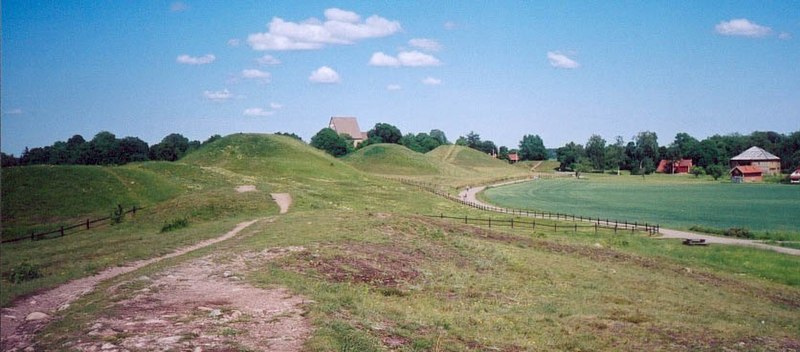
The use of falcons, hawks, or eagles to assist in this task added an extra dimension of skill and intrigue to the hunt, and especially in the early days, its “exotic” character almost certainly contributed to its prestigious reputation. And so, even more so than most varieties of hunting, falconry remained the domain of the upper ranks of Late Iron Age Germanic society—where it remained throughout the Middle Ages and into the Renaissance.
Icelandic medieval texts, such as sagas and Eddic poetry and verse, emphasise the kingliness of this sport. In the poem Rígsþula, which details the rise of the three classes of society, the children of “Jarl” (the highest rank) are specifically described as learning to hunt with birds and dogs. In the mythological realm, two of the most illustrious gods—Odin and Freyja—are described taking on the forms of raptors (eagle and falcon, respectively). In the Saga of Hrolf Kraki, Saga of Hervör and Heidrek, and Saga of the Völsungs, raptors serve as powerful symbols of the elite throughout Scandinavia. Other medieval literature describes birds of prey being given as diplomatic gifts in the Middle Ages, and there are even medieval treatises on how to keep, care for, and hunt with a variety of different birds.
Archaeologically, the first evidence for falconry in Scandinavia comes from the west royal mound at Gamla Uppsala, Sweden (early 6th c. AD), where goshawk bones were found among the burnt remains. Between then and the end of the Viking Age (c. 1100 AD), many were to follow: the famous burial grounds of Valsgärde and Vendel contain many such bones, as do over a dozen monumental graves from elsewhere in central Sweden, and even in the Salme boat burial from Estonia, which is likely to have originated from central Sweden itself. Interestingly, this region appears to have been the nexus for raptor burial in the Vendel Period, with a higher concentration found in the Mälar region of east-central Sweden than anywhere else in Scandinavia. No archaeological evidence for falconry has been discovered in Denmark or Norway during the Vendel Period; however, goshawk remains from the famous Gokstad ship burial in Norway (late 9th c. AD) show that falconry had spread to western Scandinavia by relatively early in the Viking Age.
The goshawk was the most common species occurring in these contexts, but aside from this, the osprey, sparrowhawk, peregrine, gyrfalcon, merlin, sea eagle, golden eagle, eagle owl, and snowy owl are all known from various graves. One 9th c. grave from Börje, Sweden, contained a goshawk, osprey, eagle owl, and no fewer than four peregrine falcons!
Animal accompaniment in human graves gradually waned as the Viking Age wore on and disappeared altogether as Christian burial practices were adopted. But falconry continued to be practiced by the aristocracy well into the Middle Ages, only finally receding in popularity in the 17th century.
Raptors as icons
But birds of prey represented much more than just wealth and prestige in Late Iron Age Scandinavia. They also had associations with war and death (especially the eagle), and even before we see their bones in the graves of powerful people, we may see their image on the material culture of those people. It is common to jump to the conclusion that these represent ravens—as Odin’s ravens are likely the most famous birds of Norse mythology—but the possibility that many were in fact meant to represent raptors has gained more acceptance recently.
Numerous Migration Period bracteates—coin-like gold medallions depicting gods or powerful individuals—feature images of soaring birds with hooked beaks. One of these, from Funen, Denmark (4th c. AD), portrays a mounted rider with the bird in close proximity; possibly an early depiction of falconry in action. The so-called “Snake-witch stone” from Gotland (400-600 AD) depicts a similar bird of prey alongside a boar and a wolf, also potent symbols of power and death.
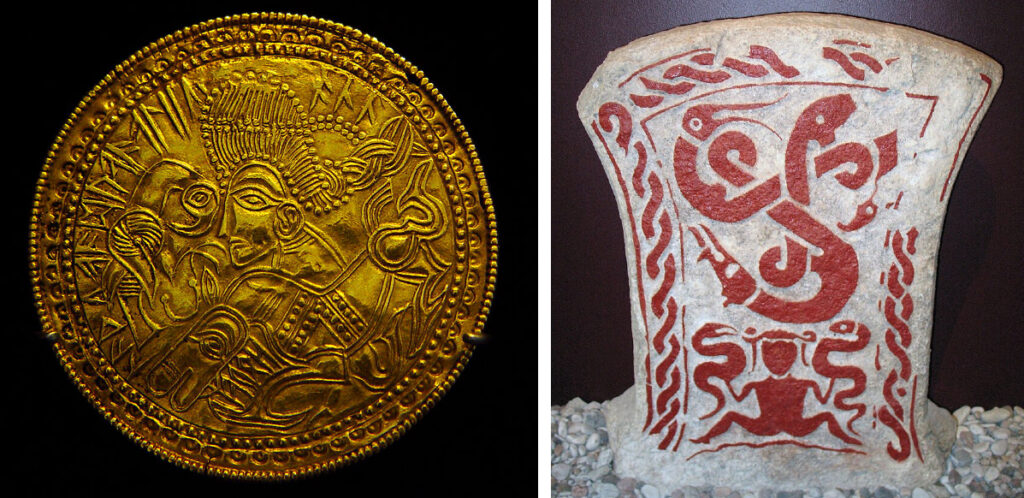
In the Vendel Period, this iconography became even more potent, with birds appearing on all manner of valuable artefacts. In Uppåkra, southern Sweden, a characteristic artefact is a bronze brooch in the form of a diving bird, over 100 of which have been found at the site. Curiously, many of these feature a human face incorporated between the wings, which may suggest they are meant to represent shapeshifting—a point in favour of these being raptors rather than ravens, given the myths of raptor shapeshifting discussed above. In central Sweden, one of the famous helmets from Vendel features a not-dissimilar diving bird as its nosepiece, though absent the human face. Dozens of other weapons and pieces of armour from this period also feature raptor motifs, including hammered plates showing men wearing raptor-crested helmets. Later, in the Viking Age, raptors became a characteristic icon of the Rus’—the hybrid Nordic/Slavic culture that developed in eastern Europe—and runestones from Scandinavia reference and depict them in various circumstances.
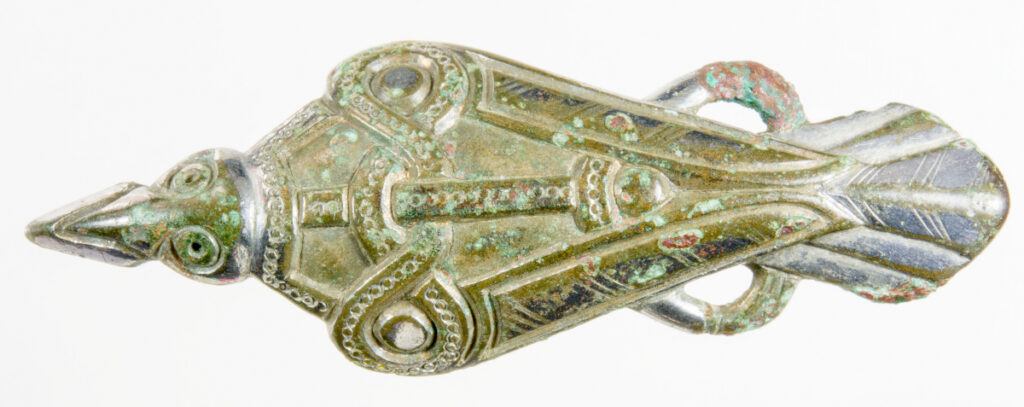
All of which is to say that birds of prey were clearly honoured for more than their ability to sit on one’s arm and go for a hunt, or even to look impressive while doing it. Their depiction on illustrious artefacts and in literature attest to significant mythic associations as well, the meanings of which we are only now truly beginning to examine. Some have suggested that these birds—along with certain other animals like dogs and horses—when placed into graves were not simply meant to signal status, but to act as guides and companions in the next life. Crucially to this, birds of prey were always buried intact, never partially or in pieces. What this seems to indicate is that they had an active role to play on the other side of death; one that required them to be whole and ready to fly when awakening with their human master in the next life.
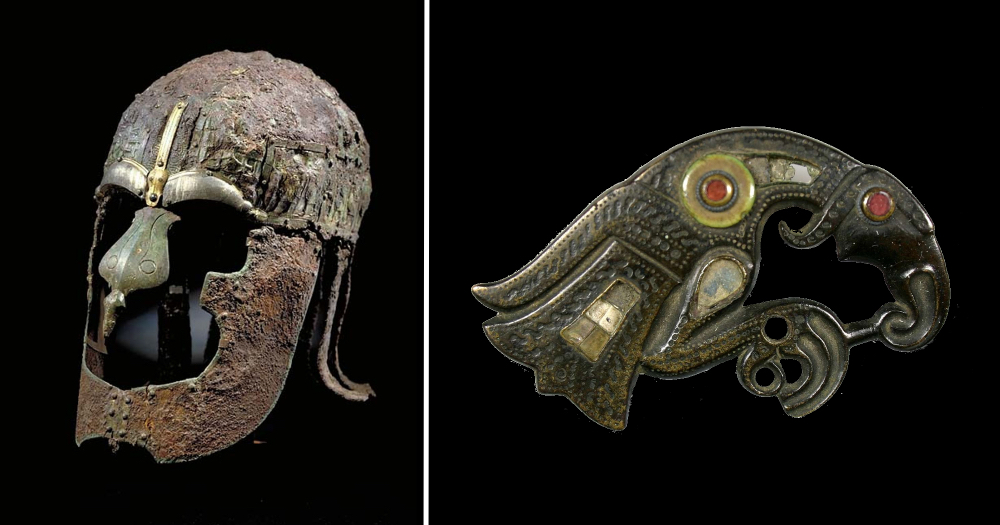
How any of these mythic connotations carried over into the hunt in this world is speculative, but almost certainly it was a symbolically-charged pursuit. Hunting has often been a ritualised activity, and it has been argued that among pagan Scandinavians—for whom the human/animal divide was not quite as clear as it was in Christian Europe—falconry took on a shamanistic dimension. Part of shamanism involves projecting the practitioner’s consciousness into the world, and perhaps the bird being unleashed by the falconer was evocative of this (especially when we consider the mythic examples of human–bird shapeshifting).
But it is clear that, in the Old Norse mythological world, Odin’s famous ravens were not the only rulers of the sky—they had to share space with the eagle, the hawk, the falcon, and even the owl.
Text: Christopher Nichols. Copyright 2023 Scandinavian Archaeology.
Cover image: Goshawk (Accipiter gentilis)(Francesco Veronesi, Wikimedia Commons).
FURTHER READING
Bellamy-Dagneau, K. 2015. A Falconer’s Ritual: a study of the cognitive and spiritual dimensions of pre-Christian Scandinavian falconry. Master’s thesis. Skemman.
Jennbert, K. 2007. The mania of the time: falconry and bird brooches at Uppåkra and beyond. In: On the Road: Studies in Honour of Lars Larsson. Hårdh, B.; K. Jennbert; D. Olausson (eds.). Almqvist & Wiksell International: pp. 24-28.
Vretemark, M. 2013. The Vendel Period royal follower’s grave at Swedish Rickeby as a starting point for reflections about falconry in Northern Europe. In: Hunting in northern Europe until 1500 AD. Grimm, O. & U. Schmölcke (eds.). Centre for Baltic and Scandinavian Archaeology. Schleswig: 207-214.
About the author
Archaeologist with a Bachelor of Arts from Simon Fraser University (Vancouver, Canada) and a Master of Arts from Uppsala University (Uppsala, Sweden). My specialisation lies in bioarchaeology broadly, with a primary focus on mammalian zooarchaeology, and a special interest in the Late Iron Age of Scandinavia (though you can occasionally catch me sniffing around Egypt as well).
In my Master research I conducted an osteological analysis of domestic dog remains from Valsgärde cemetery, Sweden. The aims were to identify the number of dogs buried at the site, reconstruct the appearance of the dogs, and identify any patterns and changes between the Vendel Period and Viking Age.
I’ve always been fascinated by the relationship between humans and animals, domestic and wild, in societies throughout the world. Through archaeology, I hope to shed light on this crucial part of our shared heritage.
